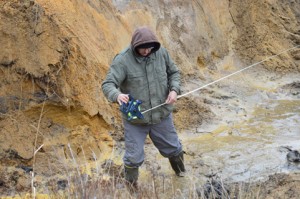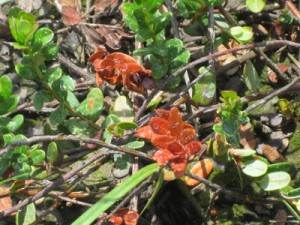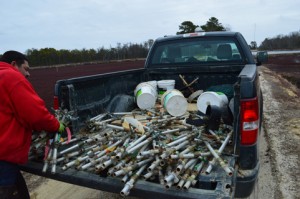Bog renovation, as always, is an ongoing project at Pine Island, and our team is moving right along! Manager of Bog Renovations Steve Manning is pleased with the current progress. “Two weeks ago, we finished Osborne Spung,” he says. “It’s been all sub-graded, we’ve built the canals and the dams, and now it’s ready for sand. We’re continuing to put sand in over at Worth Tract; Jeremy [Fenstermaker] is designing the irrigation set-up, the pumps are going in, the structures are being built. Wilfredo [Pagan] has a crew putting gates in.”
Another current project is finishing the planting at Warehouse #1. While our team planted most of that acreage back in the fall, they were only able to finish about 3/4 of the portion alloted to the Haines variety. “There was a problem getting some of the material, but ultimately it won’t really be a big deal,” says manager Mike Haines. “There’s not going to be too much of a growth difference.” Tim [Bourgeois] and Jeremy have been working on getting the planter calibrated in order to keep as few people as possible walking behind it and fixing plants. “The wet weather means we need to keep the planter out of the newer beds, so in the meantime we also have a crew out at Old 11 Acre replanting some spots that died due to Phytophthora,” Mike says. (Phytophthora is a fungus that leads to rot.)
Eliminating fruit rot is a top priority of our team. “It’s usually caused by having too much water on for too long, especially during hot and humid weather conditions,” Mike says. “Last year on these beds, I tried to sub-irrigate by bringing ditches up instead of running sprinklers. But these have a heavier soil, which holds water longer, and I ended up watering more than needed. So we considered all that and decided to keep ditches down and just water as needed. Matt [Stiles] is incorporating that as part of his irrigation plan, as well as taking some other preventive measures. Jeremy did a lot of research and found we can switch nozzles on sprinklers so we can irrigate using 33% less water, which will be great for next year when these beds will be ready for frost protection.”
“Everyone’s doing a great job; it can be really tedious hand planting everything,” Mike says. “But things have been moving faster than I’ve ever seen before!”



